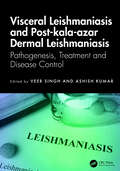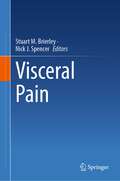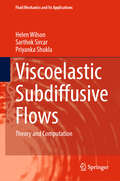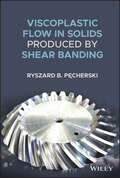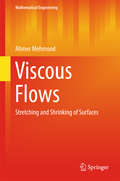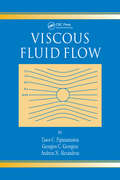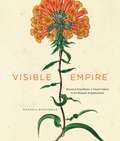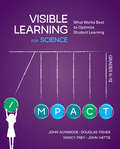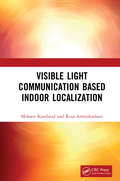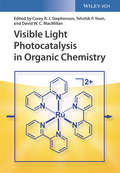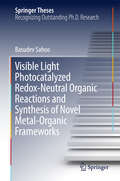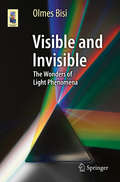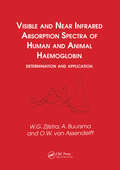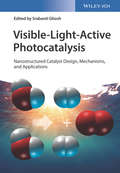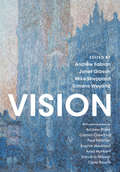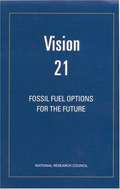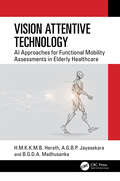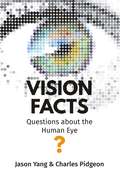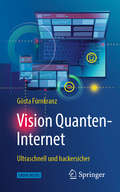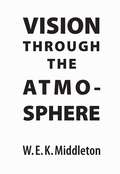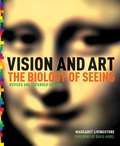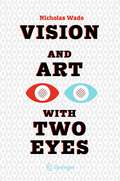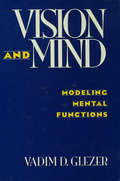- Table View
- List View
Visceral Leishmaniasis and Post-kala-azar Dermal Leishmaniasis: Pathogenesis, Treatment and Disease Control
by Pathogenesis, Treatment and Disease ControlThis reference book explores various aspects of visceral leishmaniasis (VL) and post-kala-azar dermal leishmaniasis (PKDL), including their pathophysiology, treatment options, and disease control strategies. The initial chapter provides an overview of VL, its global impact, and pathogenesis. It also examines the development of PKDL from VL, outlining the transition from the acute form of the disease to the chronic dermal condition. The book further explores the symptoms and diagnosis of both VL and PKDL. Furthermore, the book delves into the immunopathogenesis of both VL and PKDL, shedding light on the complex interactions between the parasite and the host immune system. It reviews the impact of environmental factors, particularly the contamination of arsenic and antimony in drinking water, on the progression of the disease. Lastly, the book discusses preventive measures for PKDL and highlights the major challenges in effectively implementing these strategies. This book serves as a useful resource for researchers, healthcare professionals, and policymakers seeking to deepen their understanding of these diseases and develop effective strategies for their prevention and control.Key features Provides in-depth coverage of VL and PKDL, including pathogenesis, treatment, and disease control strategies Elucidates the symptoms and diagnostic methods for VL and PKDL Offers insights into the complex immunopathogenesis of VL and PKDL, exploring the interactions between parasites and host immune system Examines treatment options for both VL and PKDL, including current therapeutic approaches and emerging strategies Reviews the impact of environmental factors, such as arsenic and antimony contamination, on the disease progression Discusses preventive measures and challenges in implementing effective strategies for PKDL prevention and control
Visceral Pain
by Nick J. Spencer Stuart M. BrierleyThe chapters in this book are based on the Visceral Pain conference in Adelaide, Australia, under the auspices of the International Federation for Neurogastroenterology and Motility in 2021. This is one of the hottest fields of science and includes mechanisms involving how the microbiome communicates with the brain and how, when disordered, these mechanisms contribute to clinical diseases such as Irritable Bowel Syndrome and Inflammatory Bowel Disease. Researchers from around the globe presented their latest findings as a review of the current state of the art in the field from both the clinical and scientific points of view. These systems are now appreciated as being critical for shaping our well-being and their disorders underlie chronic clinical conditions of significant morbidity and mortality. The author team includes long-established authorities who significantly contributed to the advances in visceral pain research over the past two decades and the new generation that will continue to contribute to advancing our understanding of the field.
Viscoelastic Subdiffusive Flows: Theory and Computation (Fluid Mechanics and Its Applications #138)
by Helen Wilson Sarthok Sircar Priyanka ShuklaThis book discusses the dynamical and rheological properties of high molecular weight entangled polymer melts, commonly known as viscoelastic subdiffusive fluids. Unlike dilute liquids, these materials exhibit molecular transport within a sublinear regime, meaning the timescale of diffusive transport is sublinear. The text emphasizes the potential of fractional calculus in modeling these fluids and introduces a novel fractional model to investigate regions of spatiotemporal instability in channel flows. At the microscale, the entanglement of polymer chains leads to localized, non-homogeneous regions with increased viscosity, which manifest as spatiotemporal macrostructures at the macroscale. To capture these macrostructures within the flow, direct numerical simulations are employed using a newly developed, physically realizable structure tensor, contributing to a deeper understanding of this complex class of fluids.
Viscoplastic Flow in Solids Produced by Shear Banding
by Ryszard B. PecherskiA complete overview of the topic of viscoplastic flow in metallic solids produced by shear banding This book presents novel ideas about inelastic deformation and failure of the material in a clear, concise manner. It exposes readers to information that will allow them to acquire the competence and ability to deal with up-to-date manufacturing and failure processes. It also portrays an interdisciplinary and revolutionary understanding of deformation processes in solids. Shear banding's typical mechanism becomes the active cause of viscoplastic flow and not the passive effect. Viscoplastic Flow in Metallic Solids Produced by Shear Banding begins with discussing the new physical model of multilevel hierarchy and evolution of micro-shear bands. It then covers the physical motivation and heuristic foundations of theoretical description concerning known results in the literature. It examines the difficulties of applying a direct multiscale integration scheme across the scales. It also presents an extension of the representative volume element (RVE) concept using the general theory of propagating the singular surfaces of the microscopic velocity field sweeping the RVE. It also reveals a new formulation of the description of the shear strain rate generated by the multilevel hierarchy of shear bands in the workflow integration approach, in which information from the simulation at different levels flows. This book: Presents fresh ideas about inelastic deformation and failure of materials Provides readers with the competence and ability to deal with up-to-date manufacturing and failure processes Sheds light on the interdisciplinary revolution in the recent understanding of deformation processes in solids Viscoplastic Flow in Metallic Solids Produced by Shear Banding will appeal to researchers studying physical foundations of inelastic deformation of materials and dealing with numerical simulations of manufacturing processes. It is also an excellent resource for graduate and postgraduate students of material science and mechanical engineering faculties.
Viscous Flows
by Ahmer MehmoodExact solution of Navier-Stokes equations is possible only for very simple flow situations such as unidirectional flows. Due to the nonlinear nature of these equations their analytic solutions are rare and the situation gets worse in the case of unsteady and multidimensional flow problems. In this book we report highly accurate and purely analytic solutions to some steady/unsteady multidimensional viscous flows over flat surface. Heat transfer analysis has also been carried out where the flat surface is considered as a stretching sheet. In each case the skin friction and the rate of heat transfer has been reported. The issue of cooling of stretching sheet in the presence of viscous dissipation has been discussed in detail. We have used homotopy analysis method to solve the governing nonlinear differential equations. The results are purely analytic and highly accurate. The accuracy of results has been proved by calculating the residual errors and (or) giving the comparison with the existing results. for unsteady flows it is worthy to mention here that our analytic solutions are uniformly valid for all time in the whole spatial domain.
Viscous Fluid Flow
by Tasos Papanastasiou Georgios Georgiou Andreas N. Alexandrou"With the appearance and fast evolution of high performance materials, mechanical, chemical and process engineers cannot perform effectively without fluid processing knowledge. The purpose of this book is to explore the systematic application of basic engineering principles to fluid flows that may occur in fluid processing and related activities.In Viscous Fluid Flow, the authors develop and rationalize the mathematics behind the study of fluid mechanics and examine the flows of Newtonian fluids. Although the material deals with Newtonian fluids, the concepts can be easily generalized to non-Newtonian fluid mechanics. The book contains many examples. Each chapter is accompanied by problems where the chapter theory can be applied to produce characteristic results.Fluid mechanics is a fundamental and essential element of advanced research, even for those working in different areas, because the principles, the equations, the analytical, computational and experimental means, and the purpose are common.
Visible Empire: Botanical Expeditions and Visual Culture in the Hispanic Enlightenment
by Daniela BleichmarBetween 1777 and 1816, botanical expeditions crisscrossed the vast Spanish empire in an ambitious project to survey the flora of much of the Americas, the Caribbean, and the Philippines. While these voyages produced written texts and compiled collections of specimens, they dedicated an overwhelming proportion of their resources and energy to the creation of visual materials. European and American naturalists and artists collaborated to manufacture a staggering total of more than 12,000 botanical illustrations. Yet these images have remained largely overlooked—until now. In this lavishly illustrated volume, Daniela Bleichmar gives this archive its due, finding in these botanical images a window into the worlds of Enlightenment science, visual culture, and empire. Through innovative interdisciplinary scholarship that bridges the histories of science, visual culture, and the Hispanic world, Bleichmar uses these images to trace two related histories: the little-known history of scientific expeditions in the Hispanic Enlightenment and the history of visual evidence in both science and administration in the early modern Spanish empire. As Bleichmar shows, in the Spanish empire visual epistemology operated not only in scientific contexts but also as part of an imperial apparatus that had a long-established tradition of deploying visual evidence for administrative purposes.
Visible Learning for Science, Grades K-12: What Works Best to Optimize Student Learning
by Douglas Fisher John Hattie Dr Nancy Frey John T. AlmarodeInquiry, laboratory, project-based learning, discovery learning—which science instructional approach is most effective? In Visible Learning for Science, the authors reveal that it’s not which strategy, but when, and plot a vital K-12 framework for choosing the right approach at the right time, depending on where students are within the three phases of learning: surface, deep, and transfer. Synthesizing state-of-the-art science instruction and assessment with John Hattie’s cornerstone educational research, this book empowers you to plan, develop, and implement high-impact instruction at each phase so all students demonstrate more than a year’s worth of learning for every year in school.
Visible Learning for Science, Grades K-12: What Works Best to Optimize Student Learning
by Douglas Fisher John Hattie Dr Nancy Frey John T. AlmarodeInquiry, laboratory, project-based learning, discovery learning—which science instructional approach is most effective? In Visible Learning for Science, the authors reveal that it’s not which strategy, but when, and plot a vital K-12 framework for choosing the right approach at the right time, depending on where students are within the three phases of learning: surface, deep, and transfer. Synthesizing state-of-the-art science instruction and assessment with John Hattie’s cornerstone educational research, this book empowers you to plan, develop, and implement high-impact instruction at each phase so all students demonstrate more than a year’s worth of learning for every year in school.
Visible Light Communication Based Indoor Localization
by Mohsen Kavehrad Reza AminikashaniThis book demonstrates the research on VLC based indoor localization in four aspects: first, it constructs the concept and model of the system; second, positioning algorithms, as the main issue in indoor localization, are detailed; third, many approaches are proposed to further improve the positioning performance; fourth, challenges will be detailed. Impulse response with multipath reflections are analyzed. Orthogonal frequency division multiplexing (OFDM) is proposed, and positioning performance is largely improved compared to On-off-keying (OOK) modulation. The readers will get a broad view of VLC based indoor localization from the background to the future challenges.
Visible Light Photocatalysis in Organic Chemistry
by Corey R.J. Stephenson Tehshik P. Yoon David W.C. MacMillanFilling the need for a ready reference that reflects the vast developments in this field, this book presents everything from fundamentals, applications, various reaction types, and technical applications. Edited by rising stars in the scientific community, the text focuses solely on visible light photocatalysis in the context of organic chemistry. This primarily entails photo-induced electron transfer and energy transfer chemistry sensitized by polypyridyl complexes, yet also includes the use of organic dyes and heterogeneous catalysts. A valuable resource to the synthetic organic community, polymer and medicinal chemists, as well as industry professionals.
Visible Light Photocatalyzed Redox-Neutral Organic Reactions and Synthesis of Novel Metal-Organic Frameworks
by Basudev SahooThis unique thesis discusses the development of conceptually novel and synthetically valuable methods that use visible light photocatalysis. Each chapter addresses a different topic in the emerging field of photocatalysis, which has become an indispensable tool for organic synthesis. Photocatalysis employs environmentally harmless and abundant visible light in the presence of a photosensitizer, and as such offers an attractive alternative to harmful UV light in photo-mediated reactions. This book introduces the novel concept of merging gold catalysis with visible light photocatalysis in a dual catalytic fashion, which demonstrates their compatibility with each other for first time and has inspired the development of various reactions. Moreover, a novel trifluoromethylation method, which combines radical addition chemistry with a polar rearrangement to synthesize valuable fluorinated compounds, is presented, since compounds featuring fluorinated functionality are the subject of increasing attention in pharmaceutical, agrochemical and material research. It also develops an external photocatalyst-free photochemical method for the synthesis of valuable indolizine heterocycles, where the product mediates its own formation. Lastly, it describes the synthesis and characterization of two novel highly porous metal-organic frameworks (MOFs). The comprehensive text is rounded out with illustrations and color figures.
Visible and Invisible
by Olmes BisiLight phenomena have intrigued humankind since prehistory. Think of the rainbow, a sunset on the sea, a game of shadows. Humans have always used light for their own needs, from cooking food to illuminating a room. However, light is not only limited to what we can see with our eyes. The invisible part of the electromagnetic spectrum is broad and dynamic. This book outlines the mysteries and wonders of electromagnetism, heat, and light. It also covers the history of our scientific understanding of light. The dark as well as the bright sides of light are fully explored in these pages, from their impact on our world to their use in cutting-edge technologies in a variety of fields. Numerous full-color images and drawings complement the text, and light phenomena are explained in a simple and engaging way.
Visible and Near Infrared Absorption Spectra of Human and Animal Haemoglobin determination and application
by Willem G. Zijlstra Anneke Buursma Onno W. van AssendelftThe bright colour of haemoglobin has, from the very beginning, played a significant role in both the investigation of this compound as well as in the study of blood oxygen transport. Numerous optical methods have been developed for measuring haemoglobin concentration, oxygen saturation, and the principal dyshaemoglobins in vitro as well as in vivo.
Visible-Light-Active Photocatalysis: Nanostructured Catalyst Design, Mechanisms, and Applications
by Srabanti GhoshA comprehensive and timely overview of this important and hot topic, with special emphasis placed on environmental applications and the potential for solar light harvesting. Following introductory chapters on environmental photocatalysis, water splitting, and applications in synthetic chemistry, further chapters focus on the synthesis and design of photocatalysts, solar energy conversion, and such environmental aspects as the removal of water pollutants, photocatalytic conversion of CO2. Besides metal oxide-based photocatalysts, the authors cover other relevant material classes including carbon-based nanomaterials and novel hybrid materials. Chapters on mechanistic aspects, computational modeling of photocatalysis and Challenges and perspectives of solar reactor design for industrial applications complete this unique survey of the subject. With its in-depth discussions ranging from a comprehensive understanding to the engineering of materials and applied devices, this is an invaluable resource for a range of disciplines.
Vision (Darwin College Lectures)
by Carlo Rovelli Paul Fletcher Andrew Blake Carolin Crawford Sophie Hackford Anya Hurlbert Dan-Eric NilssonArising from the 2019 Darwin College Lectures, this book presents essays from seven prominent public intellectuals on the theme of vision. Each author examines this theme through the lens of their own particular area of expertise, making for a lively interdisciplinary volume including chapters on neuroscience, colour perception, biological evolution, astronomy, the future of technology, computer vision, and the visionary core of science. Featuring contributions by professors of neuroscience Paul Fletcher and Anya Hurlbert, professor of zoology Dan-Eric Nilsson, the futurist Sophie Hackford, Microsoft distinguished scientist Andrew Blake, theoretical physicist and author Carlo Rovelli, and Dr Carolin Crawford, the Public Astronomer at the University of Cambridge, this volume will be of interest to anybody curious about how we see the world.
Vision 21: FOSSIL FUEL OPTIONS FOR THE FUTURE
by National Research CouncilThe committee was charged with reviewing the goals of the US Department of Energy's Vision 21 Program, the Department's vision of the future for coal-based power generation. They base their study primarily on the program's April 1999 publication, but also heard speakers from government, industry, and academia. They distill four recommendations. There is no index. Annotation c. Book News, Inc. , Portland, OR (booknews. com)
Vision Attentive Technology: AI Approaches for Functional Mobility Assessments in Elderly Healthcare
by B.G.D.A. Madhusanka H.M.K.K.M.B. Herath A.G.B.P. JayasekaraThis book provides a comprehensive overview of the use of vision attentive technology and artificial intelligence methodologies for functional mobility assessment in elderly populations.Vision Attentive Technology and Functional Mobility Assessment in Elderly Healthcare, begins with a general introduction to vision-attentive technology and its uses in the care of older people. Next it examines functional mobility in senior populations and offers a critique of the methods used today for evaluation. The authors then present several artificial intelligence approaches and vision-aware systems used for screening age related diseases such as Parkinson's disease and sarcopenia. The book also presents the difficulties and possibilities of using visual attentive technology to identify functional impairments caused by aging.This book would be helpful to researchers in the field of healthcare, especially those interested in using technology to enhance patient outcomes. Geriatricians, physical therapists, and occupational therapists who treat older patients will also benefit from reading this book. It will also be helpful to readers who are studying biomedical engineering, artificial intelligence, and healthcare.
Vision Facts: Questions about the Human Eye
by Jason Yang Pidgeon CharlesVision Facts is a question and answer guide to the wonders of the human eye, its complex structures and the process of visual perception. It traces the journey of vision from a ray of light entering the eye to the processing done by the brain, to the development and aging of the human visual system and common disorders associated with both processes. Organized in an intuitive question-and-answer format and accompanied by clear diagrams, Vision Facts provides answers regarding your vision in a manner accessible to all who are interested. Each topic includes references to external resources such as lecture notes and research papers for those who wish to delve deeper. It is a perfect handbook for anyone who is interested in visual science, sensory processing, neuroscience, or physiology; and is an excellent reference for anyone considering a career in ophthalmology or optometry.°Some examples of the questions include the following. What is the resolution of the eye? Why do astronomers often cover flashlights with a red filter while stargazing? What is color-blindness and how does it occur? What role does vision play in the circadian rhythm? What chemical signals cause the eye to develop into its mature form? How does alcohol during pregnancy affect eye development? How well can a newborn baby see? How does being born prematurely affect vision? What is 20/20 vision? How does aging affect vision? These are all questions that are addressed in Vision Facts, along with countless more.
Vision Quanten-Internet: Ultraschnell und hackersicher
by Gösta FürnkranzDie Zukunft des Internets kann fantastisch werden! Mit neuer Quantentechnologie sind hackersicherer Informationsaustausch sowie ultraschnelle Datenverarbeitung möglich. Die Basis bildet Albert Einsteins „Quantenspuk“. Dabei handelt es sich nicht um Zauberei, sondern um knallharte Wissenschaft. Dieses Buch unternimmt eine faszinierende Reise durch die Welt unserer Quantenzukunft – vom ersten „Quantensatelliten“ zum Hochsicherheitsinternet, bis hin zur Quantencloud und weiteren, teils futuristischen Applikationen.Der Autor führt den Leser durch grundlegende quantenphysikalische Zusammenhänge, erklärt die Konzepte von Quantencomputer, -Kryptografie, -Teleportation und stellt ihren Bezug zum Quanteninternet her. Besonders die gesellschaftliche Relevanz, technische Schwierigkeiten und Implementierungsbeispiele werden unter die Lupe genommen. Thematisch passende Anekdoten lockern den Text auf. Mit diesem Buch erfahren Sie, wie Quanten das Internet revolutionieren können! "… in lebendiger Sprache wird der aktuelle Stand der Forschung in seiner ganzen Breite und Pracht dargestellt – lesenswert und kurzweilig!" Rupert Ursin, Gruppenleiter und Vizedirektor des Instituts für Quantenoptik und Quanteninformation, Wien
Vision Through the Atmosphere (Heritage)
by W.E.K. MiddletonIn recent years, the problem of seeing through the atmosphere has been given intensive and costly consideration in several quarters, but particularly in the Untied States and Great Britain. A problem which once concerned mainly the meteorologists has become of great importance in military tactics as well as in peacetime transportation. The present volume is the only full account in English of the physical, physiological, and psychological factors which lie at the basis of the calculation of the range of vision through the atmosphere. There is an extended chapter on instruments and one on the author's own theory of the colours of distant objects. The figures are from many sources althrough many of them have been drawn specially for this book. The bibliography contains 420 entries nearly all of which are directly referred to in the text.
Vision and Art
by Margaret S. Livingstone David Hubel<p>With the original release of Vision and Art in 2002, Harvard professor Margaret Livingstone successfully bridged the gap between science and art, exploring how great painters fool the brain: why Mona Lisa’s smile seems so mysterious, or Monet’s Poppy Field appears to sway. In the revised and expanded edition, Livingstone presents two new chapters of her latest observations, has substantially expanded other chapters, and updates the rest of the existing text with new insights gleaned from her ongoing research, bringing the book to the cutting edge in the field of neuroscience. <p>Accompanying Livingstone’s lively prose are many charts and diagrams that lucidly illustrate her points, as well as in-depth analyses of the phenomena found in major works of art. Be it the explanation of common optical illusions or the breakdown of techniques painters use to create those illusions, Vision and Art provides a wealth of information for artists, scholars, and scientists alike.</p>
Vision and Art with Two Eyes (Vision, Illusion and Perception #3)
by Nicholas WadeThis book celebrates binocular vision by presenting illustrations that require two eyes to see the effects of cooperation and competition between them. Pictures are flat but by printing them in different colours and viewing them through similarly coloured filters (included with the book) they are brought to life either in stereoscopic depth or in rivalry with one another. They are called anaglyphs and all those in the book display the ways in which the eyes interact. Thus, the reader is an integral element in the book and not all readers will see the same things. The history, science and art of binocular vision can be experienced in ways that are not usually available to us and with images made specifically for this book. The study of vision with two eyes was transformed by the invention of stereoscopes in the early 19th century. Anaglyphs are simple forms of stereoscopes that have three possible outcomes from viewing them – with each eye alone to see the monocular images, with both eyes to see them in stereoscopic depth or rivalry, or without the red/cyan glasses where they can have an appeal independent of the binocularity they encompass. Through the binocular pictures and the words that accompany them there will be an appreciation of just how remarkable the processes are that yield binocular singleness and depth. Moreover, the opportunities for expressing these processes are explored with many examples of truly binocular art.
Vision and Light: Investigating Animal Eyes, Investigation Notebook
by The Lawrence Hall of ScienceNIMAC-sourced textbook
Vision and Mind: Modeling Mental Functions
by Vadim D. GlezerThe usual method for studying mental processes entails taking words in linguistics -- or concepts in logic -- and establishing the connections and relationships between them. Thus, the traditional approach to semantic problems -- those of meaning and understanding -- is through language. Most researchers agree that thought and language are generated by deep-seated semantic structures determined by the structure of the brain. Until now, however, all attempts at constructing semantic models have been made on the basis of linguistic material alone, without taking brain structure into account. Analysis of these models shows them to be as inadequate as those based on the method of the black box. This book approaches the problem of the organization of higher psychological functions a different way -- by analyzing the functional organization of the neural structures that gradually form universal categories from "raw" sensory material. At the higher levels of the brain's operation, these universals correspond to the basic categories of thought and language. The visual system provides rewarding material for such an approach, both because it is relatively well researched and because it is the main source of sensory information in humans. With this in mind, this monograph examines the whole process of the transformation and description -- the coding of visual information. The most important aspect of this process is the transition from the description of visual space to the description of individual objects and the relationships between them. This transition is made possible by the existence in the visual system of various mechanisms that developed during evolution as a result of environmental influences. Written for a wide circle of investigators in disciplines associated with different aspects of the functioning of the brain -- physiologists and psychologists -- this book is also of importance to engineers and mathematicians working on the problems of artificial intelligence, and linguists and philosophers interested in the deep structures that form the universals of thought and language.
